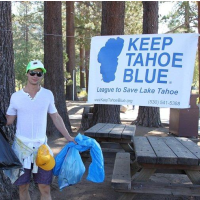Sierra Club Sues after California Gives in to Nevada on Lake Tahoe Development

Threats can work.
After Nevada politicians made it clear that they would pull out of a 43-year-old joint agreement with California for managing Lake Tahoe, which straddles their border, unless developers were given more sway and environmentalists were reined in, a new regional plan was adopted in December that did just that.
Last week, the Sierra Club and Friends of the West Shore sued to block it, claiming that the accord reached by the Tahoe Regional Planning Agency (TRPA) illegally shifted authority for development decisions to local agencies, which are eager to approve new projects at the expense of environmental protections. It accused TRPA of violating the core purpose of the interstate compact: protection of environmentally sensitive areas in and around the lake.
Lake Tahoe is one of the largest and deepest lakes in the country. It also used to be one of the world's clearest. TRPA was created in 1969 to protect the lake area from local governments and developers gone wild, but by the time the two states could enact meaningful controls in the mid-1980s, the lake was losing clarity at one foot per year. That finally stabilized, but the clarity depth of 97 feet in 1967 has been reduced to 69 feet today.
TRPA, which has representatives from both states, overcame many of the longstanding differences that separated the two sides and voted 12-1 for the changes. The only no vote was cast by the representative from the California Assembly Speaker’s office.
Nevada, which has tried to dissolve the compact between the states half a dozen times since 1975, passed Senate Bill 271 in 2011, calling for secession from the agency unless: the compact was amended to its liking; the compact incorporated those changes into a new regional plan by October 2013; and Congress and California approved the compact changes by 2015.
The legislative threat had the desired effect. Some environmental groups that had steadfastly fought to limit development reluctantly supported the new regional plan as being better than no regional plan at all. The League to Save Lake Tahoe, often a lead agency when it comes to suing TRPA, condemned the suit. California Senator Dianne Feinstein, a supporter of Tahoe environmental efforts in the past, asked Sierra Club not to go to court.
The new plan opens 300 acres of undeveloped land to “resort recreation” development, allows 3,200 new residential units and 200,000 square feet of new commercial floor space. The result, according to the lawsuit, will be “increased noise, traffic, air pollution, water pollution, loss of soil, and scenic degradation, among other impacts, none of which have been properly studied.”
–Ken Broder
To Learn More:
Sierra Club Fights Growth at Lake Tahoe (by Elizabeth Warmerdam, Courthouse News Service)
Reid, Feinstein Urged Sierra Club Not to Fight RPU (by Adam Jensen, Tahoe Daily Tribune)
Regional Plan Faces Court Challenge (by Adam Jensen, Tahoe Daily Tribune)
Federal Suit Says New Rules Will Harm Lake Tahoe (by Scott Sonner, Associated Press)
Nevada Pressure Leads to Developer Tilt at Lake Tahoe (by Ken Broder, AllGov California)
Sierra Club and Friends of the West Shore v. Tahoe Regional Planning Agency (U.S. District Court for the Eastern District of California) (pdf)
- Top Stories
- Controversies
- Where is the Money Going?
- California and the Nation
- Appointments and Resignations
- Unusual News
- Latest News
- California Forbids U.S. Immigration Agents from Pretending to be Police
- California Lawmakers Urged to Strip “Self-Dealing” Tax Board of Its Duties
- Big Oil’s Grip on California
- Santa Cruz Police See Homeland Security Betrayal in Use of Gang Roundup as Cover for Immigration Raid
- Oil Companies Face Deadline to Stop Polluting California Groundwater





